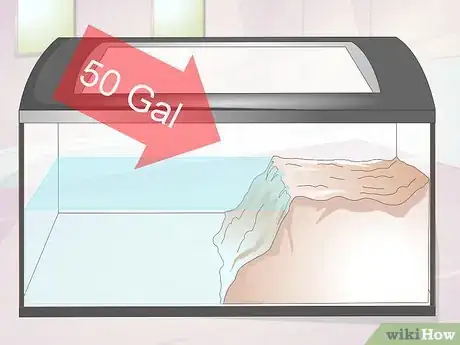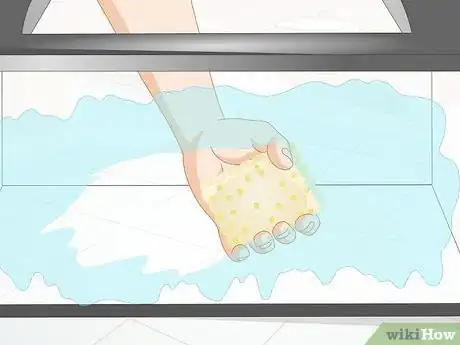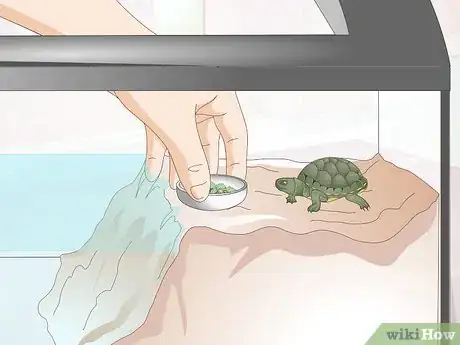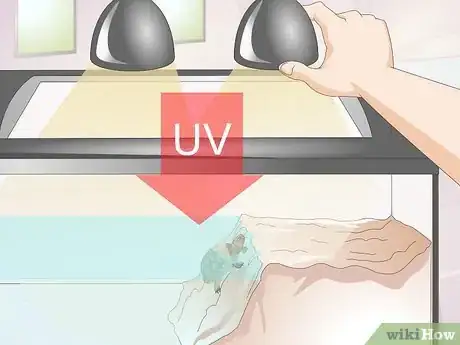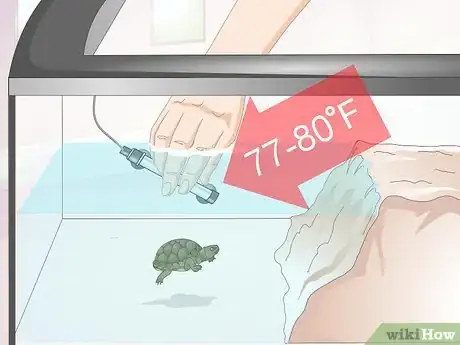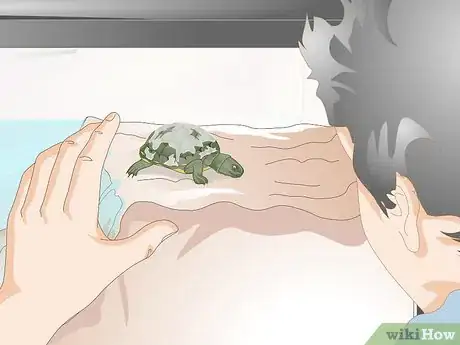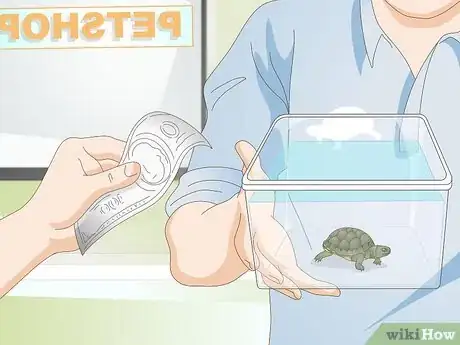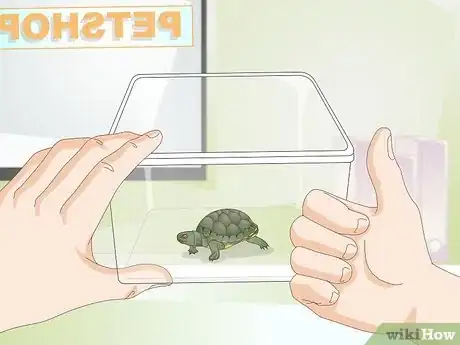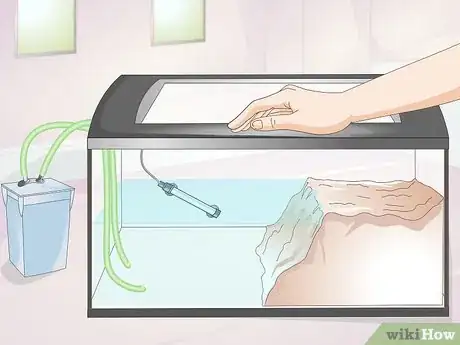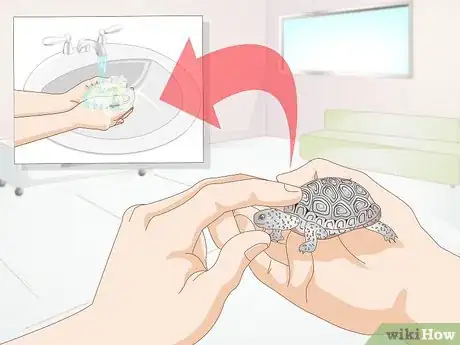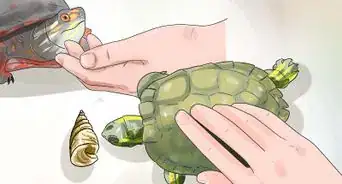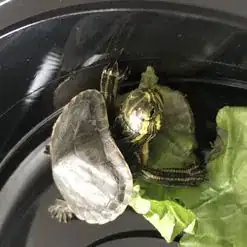This article was co-authored by Audra Barrios. Audra Barrios is a Marine Biologist and owner of Lick Your Eyeballs, a business offering experiemces, reptiles, supplies and plants. With over 15 years of experience, Audra specializes in reptiles and exotic animals, environmental education, marine biology, conservation issues, and animal husbandry. Audra earned a BASc in Marine Biology from the University of California, Santa Cruz, and studied Natural Sciences at the College of Marin. She is the founder and Executive Director of Things That Creep, a non-profit dedicated to herptile conservation through education. She has spent the last nine years working as a biologist at the California Academy of Sciences.
There are 11 references cited in this article, which can be found at the bottom of the page.
wikiHow marks an article as reader-approved once it receives enough positive feedback. This article received 31 testimonials and 95% of readers who voted found it helpful, earning it our reader-approved status.
This article has been viewed 363,025 times.
Pet turtles can be a great companion. Like all animals, turtles require careful care and attention to make sure they thrive and live healthy and full lives. From a proper habitat, nutrition, to water access, knowing your turtle's needs is an important part of pet ownership.
Steps
Keeping a Healthy Turtle
-
1Provide an enclosure with adequate space. Ten gallons per inch of your turtle is a general rule. 50 gallon (189.3 L) minimum for a baby turtle (younger than a year old) and 120+ for an adult. Make sure that you have a general idea of the size your turtle will reach when full grown so you are not blindsided with keeping a turtle you cannot maintain. [1]
- Decide on a land or aquatic turtle. Common turtles like box turtles will require a desert like landscape. If you want an aquatic turtle make sure there is dry land and adequate room to swim, and that your enclosure is sealed enough to hold water.
-
2Provide proper filtration for aquatic turtles.[2] A turtle needs a canister filter. A Rena Filstar XP3 or XP4 is highly recommended in keeping a turtle healthy. Without good filtration your turtle can get extremely sick as old food and feces can build up.[3]
- Even with proper filtration, you'll need to regularly change your turtle's water.[4] When you change the water, make sure that the filter is not clogged. If you see waste or old food lingering in the filter, it may cause a clog that prevents it from filtering the water properly. You can buy a dechlorinator or water conditioner at any pet store.
Advertisement -
3Clean your tank regularly. Remove everything from the tank including all of its basking spots and empty the water. Wash everything with warm water and anti-bacterial soap. Let rocks sit in warm water and soap. Wash the soap out thoroughly. Let the tank sit until it is dry. Put everything back in and fill the tank with clean, non-chlorinated water. If it is a land turtle, make sure to replace with clean substrate on the bottom of the tank each time, such as sand, wood chips, or newspaper. [5]
- How often a clean is necessary will depend on how messy your turtle is. It is generally a good idea to do this at least twice a month. Make sure to wash your hands thoroughly after cleaning the tank.
-
4Provide a balanced diet for your turtle. A proper diet for Red Eared Sliders and similar species should have the following proportions: Vegetables and water plants 50%; Commercial foods 25%; Live protein 25%. A turtle under a year old should be fed every day. A turtle over a year old should be fed every other day as to prevent them from getting overweight. [6]
- An example of vegetation for your turtle are aquatic plants like duckweed, azolla, and water lettuce. They also enjoy fruits and vegetables like papaya, carrots, apples, and leafy greens like romaine lettuce.
- For protein, your turtle can eat cooked chicken, turkey, or raw beef. If you want to feed your animal live protein, mealworms, snails, wax worms, beetle larvae, or even small goldfish are great.
- There are also commercially available diets, such as pellets, that can provide complete nutrition for turtles. Make sure that you read the ingredients carefully and that proportions of protein and vegetable based matter are at proper ratios.
-
5Make sure your turtle has proper lighting. If your turtle does not have regular access to sunlight, you will need to provide UV light bulbs for basking.[7] Turtles in the wild are exposed to sunlight every day and the nutrients they provide are essentially for healthy growth and development. The amount of light it needs will be based on the species with land turtles usually requiring more. [8]
- Keep in mind that that UV cannot penetrate glass and will need to above or in the enclosure.
- Change out your turtle's UV bulb every 6 months. Over time the bulb will stop emitting enough UV light.[9]
-
6Maintain proper water temperatures. You will need a water heater. Turtles are cold-blooded animals and thus rely on external heat to warm up their bodies. If the temps get too high or too low it can turn fatal. The water should be 80 - 82 degrees Fahrenheit ( 26.5 - 27.5 Celsius) for a hatchling or a sick turtle, and 77 - 80 degrees F (25.5 - 26.5 C) for a healthy turtle over a year old.[10]
- The basking (dry land) area should be 10 degrees Fahrenheit (6 degrees Celsius) warmer than the water to entice the turtle to warm up by basking.
-
7Look for signs of sickness in your turtle. Even if you do your best to keep your turtle healthy, there are many diseases that can commonly affect the health of your pet. However, most are treatable if you look for certain telltale signs, you can start quickly getting your pet better.
- Vitamin A deficiency. This occurs when your turtle is not getting a proper diet and manifests as lack of appetite, swelling of eyelids, swelling of ears, and persistent respiratory difficulties. This can also affect the buoyancy of your turtle when it's swimming. You can correct this by making sure your turtle has a balanced diet.
- Respiratory infections. The most common signs of this are wheezing, difficulty breathing, bubbles and mucus in their nose, and frequent coughing. If you see these symptoms, take your turtle to the vet who will give them an x-ray and determine the proper antibiotic course. The most common cause of these issues are improper basking and water temperatures or an exposure to drafty conditions.
- Shell rot. This is a fungal condition to the shell. The symptoms include: white, slimy, smelly appearance of the shell and sometimes puss. The symptoms may also include small abrasions on the turtle's shell. If you see any of these signs, take your turtle to the vet who will prescribe antibiotics.
- Parasites. These are the most common cause of illness. The most common parasites for turtles are: pinworms, roundworms, and hookworms. The signs include lack of appetite, undigested food in stool, weight loss and sometimes spit up of food. Your vet will ask you obtain a stool sample to test for parasites and give a medication targeted to rid the turtle of the specific parasite.
- Find a good vet that specializes in herpetology. Not all vets will deal with exotic animals. Make sure that whatever vet you choose has a specialty in herpetology and can help your turtle. Look online for a good local herp vet with strong reviews and demonstrated speciality background. Call local vet offices to see if they can treat turtles, or if they know a good colleague that can.
Deciding on a Turtle
-
1Decide the type of turtle you want. There are different types of turtles available for purchase. These can present different difficulties in care, cost differences, and differences in how tame or docile the animal is. [11]
- Painted turtles are a great aquatic species for beginners. This is a colorful variety of turtle, readily available, easy to care for and great for a new turtle owner. They stay small, only 4 to 5 inches, and are active. They're also commonly bred in captivity and years of breeding has created a docile and tame animal. They are recognizable for their colorful markings that make them appear "painted," hence the name.
- Common Musk Turtles. These are a small, relatively hearty, aquatic turtle. They can rest comfortably in a small tank (as small as 30 gallons) but do not generally like to be handled.
- Slider turtles. There are many varieties of sliders with two being the most common — the red eared and yellow bellied slider. They stay under 11 inches and are easy to care for. They also have tame and docile personalities.
- Diamondback Terrapin. This is another type of turtle commonly available in pet stores and amongst breeders. While these turtles stay small (9 inches at the most) and are friendly, they require a little more expertise than either painted turtles or sliders. They prefer brackish water (a slightly salted water) and thus will require more work.
- Tortoises are a type of land turtle. They can live up to 100 years, so they're a long-term commitment.[12]
-
2Find a reputable turtle breeder or seller. Many pet stores will sell a variety of turtles. However, you will want to know the provenance of your turtle before bringing it home. This can include whether it was captive bred or caught from the wild. In addition to this you will want to make sure that the turtle is being kept in a proper habitat and appears alert and healthy. [13]
- Ask for proof that the turtle was captive bred. If the breeder cannot provide this, chances are the turtle was born in the wild. This can have detrimental effects on wild turtle populations and also make your turtle more prone to stress, which is potentially detrimental to the animal's health.
-
3Make sure you choose a healthy turtle. Since many turtles can be bred in poor conditions or undergo the stresses of being captured from the wild, it is important to choose a healthy looking turtle. The turtle should be alert, free of any parasites, and relatively active. You will want to see that the turtle has an appetite and looks properly fed. Their eyes should be clear, no bubbles from the nose while breathing or wheezing sounds. The limbs should be strong and moving when picked up; listlessness is a sign of illness. There should also be no cracks or pits in the shell or sign of wounds. [14]
- Check the enclosure. The water should be clean, food should be available and adequate light provided. If any of these are missing, it can increase the likelihood you bring home a sick turtle.
-
4Make sure you are prepared for the turtle at home. Besides all of the commitment requirements, make sure that your turtle's habitat is ready to go before you pick the turtle up. This way they can start acclimating to their new life right away.
-
5Always practice safe handling. Whether you are the primary caregiver, or a child is regularly handling the turtle, be cognizant of potential diseases they may carry. Turtles can carry salmonella or other infectious diseases. This can also be contracted by contact with their enclosure. Make sure to practice safe handling measures and wash your hands thoroughly after each contact with the enclosure or turtle. [15]
- Elderly people, children and infants are particularly susceptible to salmonella. Even if they are not directly interacting with the turtle or its environment, you will want to wash your hands thoroughly before coming in contact with at risk individuals.
Expert Q&A
Did you know you can get expert answers for this article?
Unlock expert answers by supporting wikiHow
-
QuestionWhat kind of light do I need for an aquatic turtle?
 Audra BarriosAudra Barrios is a Marine Biologist and owner of Lick Your Eyeballs, a business offering experiemces, reptiles, supplies and plants. With over 15 years of experience, Audra specializes in reptiles and exotic animals, environmental education, marine biology, conservation issues, and animal husbandry. Audra earned a BASc in Marine Biology from the University of California, Santa Cruz, and studied Natural Sciences at the College of Marin. She is the founder and Executive Director of Things That Creep, a non-profit dedicated to herptile conservation through education. She has spent the last nine years working as a biologist at the California Academy of Sciences.
Audra BarriosAudra Barrios is a Marine Biologist and owner of Lick Your Eyeballs, a business offering experiemces, reptiles, supplies and plants. With over 15 years of experience, Audra specializes in reptiles and exotic animals, environmental education, marine biology, conservation issues, and animal husbandry. Audra earned a BASc in Marine Biology from the University of California, Santa Cruz, and studied Natural Sciences at the College of Marin. She is the founder and Executive Director of Things That Creep, a non-profit dedicated to herptile conservation through education. She has spent the last nine years working as a biologist at the California Academy of Sciences.
Marine Biologist & Reptile Specialist
-
QuestionHow long can turtles stay on land?
 Community AnswerTurtles can stay on land (or without water) up to two days. But they usually like to have food inside the water. They shift from water to land and vice versa several times for basking and swimming, so it is best to provide an environment convenient for them.
Community AnswerTurtles can stay on land (or without water) up to two days. But they usually like to have food inside the water. They shift from water to land and vice versa several times for basking and swimming, so it is best to provide an environment convenient for them. -
QuestionHow do I clean the turtle's shell?
 Community AnswerA regular toothbrush is very helpful to clean the shell, just scrub gently.
Community AnswerA regular toothbrush is very helpful to clean the shell, just scrub gently.
Warnings
- Do not feed the turtle red ants, mealworms or spinach.⧼thumbs_response⧽
- Don't put stones or other ornaments with sharp or ragged edges in your turtle's tank, they may hurt it.⧼thumbs_response⧽
- Don't turn your turtle upside down in water, it might not be able to breathe.⧼thumbs_response⧽
References
- ↑ http://www.austinsturtlepage.com/Articles/firstturtleenclosure.htm
- ↑ Audra Barrios. Marine Biologist & Reptile Specialist. Expert Interview. 18 August 2020.
- ↑ http://www.reptilesmagazine.com/Turtles-Tortoises/Information-News/Keeping-Your-Turtle-Healthy/
- ↑ Audra Barrios. Marine Biologist & Reptile Specialist. Expert Interview. 18 August 2020.
- ↑ http://www.petmd.com/reptile/care/evr_rp_turtles-101-how-to-clean-and-care-for-your-turtles-tank
- ↑ http://www.fishpondinfo.com/turtles/turfeed.htm
- ↑ Audra Barrios. Marine Biologist & Reptile Specialist. Expert Interview. 18 August 2020.
- ↑ http://www.drsfostersmith.com/pic/article.cfm?aid=827
- ↑ Audra Barrios. Marine Biologist & Reptile Specialist. Expert Interview. 18 August 2020.
- ↑ http://www.hartz.com/Reptiles/Getting_Started/how_to_care_for_aquatic_turtles.aspx
- ↑ http://www.myturtlecam.com/choose.php
- ↑ Audra Barrios. Marine Biologist & Reptile Specialist. Expert Interview. 18 August 2020.
- ↑ http://www.peteducation.com/article.cfm?c=17+1797&aid=946
- ↑ http://small-pets.lovetoknow.com/reptiles-amphibians/purchasing-pet-turtles
- ↑ http://www.fda.gov/ForConsumers/ConsumerUpdates/ucm048151.htm
About This Article
To keep a turtle healthy, make sure it's eating about 50 percent vegetables and water plants, 25 percent live protein, and 25 percent commercial foods so it's getting all of the nutrients it needs. You should also change out the water in your turtle's tank regularly so it doesn't get dirty, and use a canister filter to help keep the water clean. Also, if your turtle doesn't have access to sunlight, place UV light bulbs above or inside the enclosure so it has light to bask in. For more tips from our Veterinary co-author, like how to tell if your turtle is sick, scroll down!
